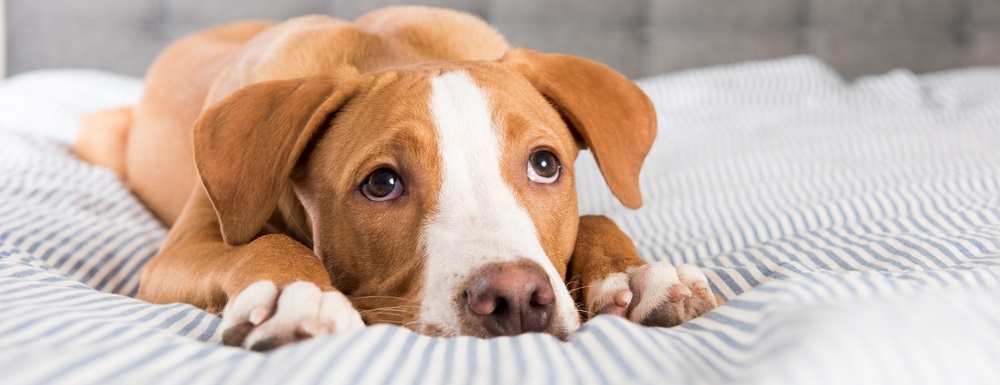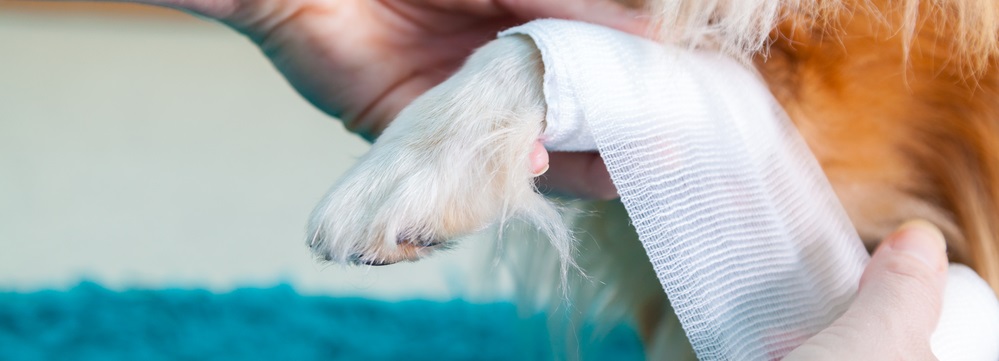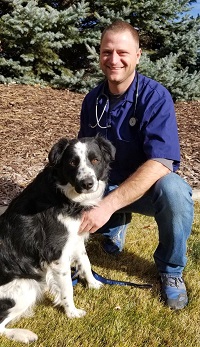Your relationship with your dog might be one of the most important in your life, and for good reason. Pets provide comfort, support, and never-ending love. They can also get into all kinds of mischief when left to their own devices, which leaves you to clean up the mess.
Thankfully, not every accident requires veterinary care.
If it’s a minor wound that doesn’t require professional medical attention, you can equip yourself with the knowledge and resources to help your furry friend from home. Here’s how to clean a dog wound at home, including the necessary materials.
Assess the Situation
The most significant factor in the health and cleanliness of your dog’s wound is how quickly you can properly clean and treat it. Any length of time spent romping around in the backyard with an open wound dramatically increases the chance of wound infection.
IMPORTANT: If you’re unsure how to proceed, you should always err on the side of caution and seek veterinary attention or take them to an emergency animal hospital if necessary.
You might have to wait a few hours or even days for your scheduled appointment. In the meantime, ensure your dog is walking only on hard, clean surfaces—no carpet where debris and other unknown particles can hide, and certainly no dirt, gravel, or grass—and limit weight-bearing as much as possible.
WHEN SHOULD YOU BRING YOUR DOG TO THE VET
When it comes to treating dog wounds and injuries, there are a few types that should always be treated by a veterinarian:
- Animal bites – Oftentimes, the animal’s teeth will inject bacteria deep under your pet’s skin. You won’t necessarily be able to clean a bite wound, whether it be a dog bite or other animal bite, properly at home.
- Punctures with an unknown source – A puncture wound from an unknown source should be treated as a worst-case scenario, just to be on the safe side. For example, the seemingly minor wound could have been sustained from a rusted nail.
- Cuts more than an inch long or with jagged edges – Larger wounds such as these are typically more serious injuries and should not be treated at home.
- Wounds sustained to the chest or abdomen – Seemingly minor injuries to the abdomen or chest are often much more serious. There could be internal bleeding or other damage beneath the surface level scrape or cut that can’t be seen. A veterinarian has the tools to assess this.
f your dog has a small wound that’s unconcerning, you should be able to handle it on your own with this helpful dog wound care guide.

Cleaning & Disinfecting Minor Wounds
To treat minor pet wounds like a cut or scrape is akin to treating a human. The primary goal of wound care is to remove any foreign objects that could lead to infection and sanitize the exposed area. The other main objective is to eliminate pain by using gentle, soothing products on your pet’s wound.
With this firmly in mind, here are 7 steps to properly clean a dog wound.
#1 SECURE THE ANIMAL CALMLY
For smaller dogs, clear off a table and layer it with clean towels or blankets for comfort. If your dog is too large (or your table is too small), make space on the floor where you can kneel comfortably around them.
Enlist an assistant to gently restrain the dog and keep them calm. It’s always best to find someone the dog recognizes and feels safe around. If this isn’t possible, you might have to be both assistant and pet-doctor.
Before you begin, you’ll need to apply a muzzle or makeshift substitute using a leash or strap. This isn’t fun, but you have to be prepared—any dog can be prone to biting when distressed or in pain, no matter how sweet and gentle they usually are. Please be careful when restraining your pet so as not to cause additional discomfort or injury.
#2 STOP ANY BLEEDING
It’ll be impossible to properly clean the wound if blood is still coming out of it.
Apply pressure to the area with either a small gauze pad or a household towel, depending on the size. Don’t overly concern yourself with sanitizing the cloth before using it, as the target area has not yet been cleaned.
Eventually, this pressure will cause the blood vessels to clot and slow to a halt.
Warning Sign: If the blood appears to be spurting out at short, consistent intervals, this could be considered a “pumper.” This means the blood will continue to shoot out with every heartbeat, no matter how much pressure you apply or for how long. If this appears to be the case, you should abandon your at-home attempt and seek emergency care immediately .
#3 SNIP THE SURROUNDING HAIR FOR EASY ACCESS
First, cover the dog wound area with Vetericyn Plus Wound Cleanser—steer clear of oil-based ointments like Vaseline or petroleum jelly. A suitable cleanser will make it easier to remove the detached hair that may otherwise stick to the open sore.
Next, use electric clippers to remove the hair from the wound and the surrounding area; scissors or household razors can be used as a last resort as long as you proceed with extreme caution to avoid further breaking the skin.
#4 FLUSH ANY DEBRIS
Even if you can’t see rocks or glass with the naked eye, there’s a good chance that microscopic particles of bacteria, dust, or other unknown materials have contaminated the wound.
If you do see any larger, visible objects, like twigs or gravel, you can pick them out with your hands or a clean pair of tweezers. Afterward, rinse the wounded area with Vetericyn wound-treatment solution (link). Unlike relying on running water, blasting it with liquid will serve to dislodge anything too small to be removed with the tweezers.
Next, pat it dry with a clean towel or sterile gauze. At this point, the towel must be unsoiled from previous use, as drying a freshly cleaned and open wound with a contaminated cloth will undo the effects of the last step.
#5 CLEAN WITH A MODERN DAY WOUND & SKIN CLEANSER (STAY AWAY FROM THE OLD AND DATED SOLUTIONS STILL LINGERING AROUND IN THE MEDICINE CABINET)
Choose carefully when selecting a wound cleanser as many treatment products can cause further irritation, damage previously healthy tissue, and may be toxic to dogs. To prevent your pup from licking the disinfectant off, they may require a surgical recovery cone.
WHAT NOT TO PUT ON A DOG WOUND
People often cite chlorhexidine as an effective antibacterial wound treatment. While it may be relatively innocuous if adequately diluted, this same product is also used widely as a disinfectant for surgical instruments and household surfaces.
Do you brush your teeth with the same chemical you use to scrub the floors? Then why would you clean your dog’s paw with the same compound doctor’s employ to sanitize their scalpels?
In fact, studies on the effects of chlorhexidine on healing wounds show that the compound can damage new tissue, causing permanent harm to the meninges and mucous membranes and delaying the wound healing process. There is also a chance that certain harmful microbes can grow in the solution, rendering its antibacterial properties obsolete.
Here is a non-exhaustive list of other chemicals to NOT put on a dog wound:
- Hydrogen peroxide
- Iodine
- Rubbing alcohol
- Benzalkonium chloride
WHAT TO PUT ON A DOG WOUND
Instead of using an irritating chemical, choose a non-toxic wound and skin care treatment to avoid making the wound worse during the cleaning process.
#6 APPLY AN ANTIBIOTIC OINTMENT OR HYDROGEL
As long as the wound remains open, it is at risk of becoming infected. A thin layer of an antimicrobial hydrogel will keep the wound clean as it heals and provide soothing relief for your canine companion.
It is entirely safe if licked or otherwise ingested, which will give you one less thing to worry about as you care for your dog.
#7 COVER WITH A BANDAGE
The same ointment or gel functions as an excellent wound dressing by donating moisture to the site. Apply a layer then cover the wound with a bandage to prevent contamination and discourage your dog from licking or biting at it.
A square bandage will work for most areas of the body. If the wound is on the paw or leg, secure the dressing with an elastic.
Warning Sign: Swelling in the dog’s paw or toe pads is an indication that the elastic is too tight and restricting blood flow. Check the toe pads regularly for signs of inflammation. Compare them against the uninjured foot to double-check you are not cutting off circulation. At the first indication of swelling or other irregularities, remove the elastic and rewrap it.
Maintaining A Clean Wound
After the initial wound cleaning procedure, it’s essential to check in regularly by examining your pet’s wound for any abnormalities or developments.
It can be helpful to take pictures each day to allow for easy comparison. If all is going according to plan, you should notice subtle improvements over time.
Warning Sign: If there are no changes after a week or the condition is worsening in any way, you should seek veterinary attention.

DAILY CARE AND TREATMENT
For the best daily care and wound management, repeat steps 5, 6, and 7, three times each day.
If you regularly apply a cleaning solution and a protective antimicrobial gel, the wound should begin to heal itself without the risk of infection.
When re-applying wound dressings or bandages, first soak them in the same antibacterial ointment you’ve been using on the injury itself. The underlying tissue will heal faster if it’s consistently moistened.
Once the wound is no longer open but still in the final stages of the healing process, you shouldn’t need to wrap it in a bandage. However, you should continue to apply both the cleanser and the cooling gel until your dog has recovered completely. Keep them from licking the treatment for at least ten minutes after its application—it won’t hurt them, but it also won’t do much good on their tongues when it was intended for their paws.
Showing Up For Your Furry Friend
Figuring out the best course of action in a moment of fear and confusion can be difficult, but it’s important to remain calm and resolved for your injured pup. It’s your job to support them when they’re feeling scared—unfortunately, they don’t have the means to tell you what they need.
By following this guide on how to clean a dog wound, you should be equipped to patch up your pooch in times of need. Here at Vetericyn that means using the best pet wound care products available, and our Vetericyn Plus® Antimicrobial All Animal Wound and Skin Care is an essential part of every dog’s first aid kit.
 Reviewed by Dan Richardson, Veterinarian
Reviewed by Dan Richardson, Veterinarian
Dan Richardson has been a practicing veterinarian for over 10 years. He specializes in surgery and orthopedics. Dan is originally from rural western Nevada and attended the University of Idaho for undergraduate study and Oregon State University for Veterinary School. The Richardson Family enjoys camping and spending time on the water fishing, paddle boarding, or digging their feet in the sand somewhere warm.
Sources:
- VCA Hospitals. Care of Open Wounds in Dogs. https://vcahospitals.com/know-your-pet/care-of-open-wounds-in-dogs
- PetMD. How To Clean and Treat Dog Wounds at Home. https://www.petmd.com/blogs/fullyvetted/2013/april/how-to-take-care-of-your-pets-minor-wounds-30187
- International Journal of Morphology. A Comparison of the Effect of Chlorhexidine, Tap Water and Normal Saline on Healing Wounds. https://scielo.conicyt.cl/pdf/ijmorphol/v24n4/art25.pdf